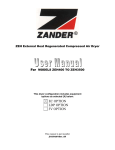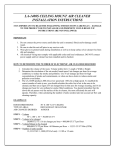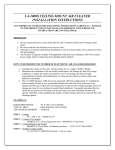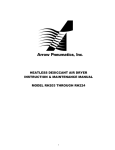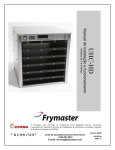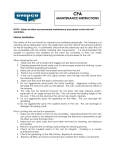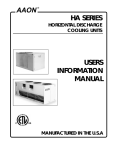Download AER CYCLONES TABLE OF CONTENTS
Transcript
1 AER CYCLONES TABLE OF CONTENTS 1. IMPORTANT NOTICE 1.1 General Cautions ………………………………………… ………………………………………… Page 2 2 2. INTRODUCTION ………………………………………… 2.1 Unit Nomenclature ………………………………………… 2.2 Description and Operation ………………………………… 2.3 Air Filtering Operation ………………………………………… 2 2 4 4 3. SPECIFICATION TABLE 4 ………………………………………… 4. INSTALLATION ………………………………………………… 4.1 Off loading and Inspection ………………………………… 4.2 Installation Planning ………………………………………… 4.3 Assembly of Standard Equipment ………………………… 4.4 Assembly of Optional Equipment ………………………… 4.5 Electrical Installation ………………………………………… 5 5 5 7 9 11 5. OPERATION 5.1 Start-Up 5.2 Check List 12 12 12 6. SERVICE ………………………………………………… 6.1 Dust Removal ………………………………………………… 6.2 Servicing the Direct Drive Motor and Fan ……………..….. 6.3 Servicing the Belt Driven Fan and Motor …………...……. 6.4 Belt Adjustment and Replacement ………………………… 6.5 After filters …………………………………………… ………………………………………………… ………………………………………………… ………………………………………………… 7. TROUBLESHOOTING GUIDE 8. WARRANTY STATEMENT 12 13 13 15 16 16 ………………………………… 17 ……………………………………. 18 2 1. IMPORTANT NOTICE This manual contains important safety information and precautionary measures. It is impossible to list all potential hazards associated with every dust collection system in each application. Proper use of the equipment must be discussed with AER or your local AER representative. Operating personnel must be aware of, and adhere to, the most stringent safety procedures. 1.1 GENERAL CAUTIONS ON USING DUST CONTROL EQUIPMENT 1. Avoid mixing combustible materials such as aluminum, paper, wood or other organic dusts with dusts generated from grinding or welding metals. A fire hazard could develop from sparks entering the dust collector. When collecting flammable or explosive materials, the dust collector should be located outdoors and incorporate the appropriate safety measures and/or accessories. 2. When collecting emissions from spark-producing processes, care must be taken to reduce any potential fire hazards. Dust collectors do not contain fire extinguishing equipment unless specifically ordered. Consult fire extinguishing experts for recommendations concerning proper fire detection and suppression systems. 3. Some dust collection systems require explosion venting. Consult your insurance underwriter, NFPA (National Fire Prevention Association) Manual and local fire authorities to determine requirements for explosion venting. 4. Be careful and conscientious – consult national and local fire codes, waste disposal, safety and other appropriate authorities. Comply with their recommendations for proper installation and operation of dust collection equipment. 2. INTRODUCTION Thank you for selecting AER. dust collection equipment to assist you in your commitment to a clean and safe environment. We trust that in purchasing our product you have recognized our commitment to continually offer dust collection equipment engineered to each dust collection need and manufactured to the highest standards. The AER. High Efficiency Cyclone Dust Collector is designed to collect processgenerated dusts. The ATC-Series cyclone provides continuous duty operation in its application to improve the work environment. As you review this manual, refer to Figure 1 for assistance locating unit parts. 2.1 UNIT NOMENCLATURE Example: ATC-205 ATC = High Efficiency Cyclone Dust Collector 20 = Cyclone Diameter in inches 5 = Horsepower of drive motor 3 4 2.2 DESCRIPTION AND OPERATION ATC-Series cyclones are high-efficiency dust collectors designed to eliminate airborne dust as it is generated. Contaminants are captured at the source(s), and then conveyed through ductwork to the collector where the dust is separated from the air stream and collected. The primary mode of operation is the air cleaning operation. The separated dust is discharged into a collection container. The cleaned air is then exhausted into the atmosphere or further filtered through afterfilters. 2.3 AIR FILTERING OPERATION Normal operation consists of the air filtering operation and the resulting cleaned air discharge. During the air filtering operation, contaminated air is drawn into the AER Cyclone Dust Collector through the air inlet located on the upper barrel above the internal helix (see Figure 1). The contaminated air spirals down and accelerates as the cone narrows whereby higher centrifugal forces are exerted on dust particles in the air stream. As the contaminated air travels down the cone, it accelerates and the particles are thrown to the periphery of the air stream. Aided by gravity, the heavy particles are discharged into a dust-tight container (i.e. drum or hopper). As the particles drop out, the exhaust air stream spirals upward inside the downward stream of contaminated air into the fan housing and is then exhausted into the atmosphere. NOTE: For fine dust and dust with low densities, the cyclone should be considered only as a pre-cleaner. Secondary filtration may be required. 3. SPECIFICATION TABLE Model CFM STD Inlet STD Outlet Motor TEFC H.P. ATC-162 ATC-203 ATC-205 ATC-207 ATC-247 ATC-2410 ATC-3010 ATC-3015 ATC-3620 ATC-3625 ATC-4030 ATC-4040 ATC-4440 ATC-4450 800-1200 1250-2000 1500-2250 2000-3500 2000-3500 2500-4000 3000-4500 4000-5500 4500-7000 4500-7500 5000-8000 5000-8000 8000-11500 8000-13000 6” 8” 8” 10” 10” 10” 12” 12” 14” 16” 16” 16” 18” 18” 8” 10” 10” 12” 12” 12” 14” 14” 16” 18” 18” 18” 20” 20” 2 3 5 7½ 7½ 10 10 15 20 25 30 40 40 50 5 4. INSTALLATION 4.1 OFF LOADING AND INSPECTION ATC-Series cyclone units are shipped with major components mounted on skids, size permitting. The blower assembly will be pre-assembled to the upper barrel assembly. The orientation will have the inlet and outlet opposed 180 deg. unless requested otherwise at the time of order. Other skids may contain afterfilter units or other accessory components. As soon as the equipment arrives, it should be carefully inspected to make certain all items on the packing list are present and in good condition. Even though the equipment is mounted on heavy shipping skids at the factory, damage can occur during shipment. Note damage or missing items on the Bill of Lading. The PURCHASER should take immediate steps to file reports and damage claims with the carrier. Damage to a unit in transit is the responsibility of the carrier since it is AER policy to make shipments FOB factory (i.e. ownership passes to the purchaser when the unit is loaded and accepted by the trucking firm). Any claims for transit damage or shortage must be brought against the carrier by the purchaser. AER will provide assistance to the purchaser if necessary. 4.2 INSTALLATION PLANNING Selecting the proper location for your dust collection equipment is very important. See Figure 2 for typical installation details. Certain items should be considered when locating the unit, such as: room to empty the dust storage container(s) or hoppers; shortest run for location of ductwork; electrical connections; wall penetrations; fan discharge direction; and afterfilters. Ease of maintenance should also be considered when selecting the location and orientation of the system !!!!! CAUTION !!!!! Do not locate dust collector near dust source in cases where the dust is explosive or a fire hazard. !!!!! CAUTION !!!!! In preparing to install the unit, ensure location is clear of all obstructions, such as utility lines or roof overhangs, so the crane is free to maneuver if needed. 6 7 4.2 Continued The AER Cyclone Dust Collector is usually mounted on a reinforced concrete foundation. Other mounting options are possible. Structural calculations for the foundation or other mounting arrangement must include the weight of the equipment. These weights must be considered together with wind, seismic and other live load ratings when designing the support structure. Interconnecting ductwork (not provided with the Cyclone Dust Collector) should be designed and properly sized to handle the air volume at the recommended air velocities of the entrainment of dust into the collection system. When installing ductwork, use shortest possible runs and long-radius elbows whenever possible. The shortest duct length with a minimum number of elbows will maximize the performance of the unit. Seal all joints. Follow ductwork design methods as listed in the Industrial Ventilation Manual as recommended by the American Conference of Governmental Industrial Hygienists. In the case of spark-producing processes, system design should incorporated measures to prevent live sparks from entering the dust collector. Consult local authorities for the location of this unit and any precautions to consider when collecting combustible, explosive or hazardous dusts. Review General Cautions listed on page 2. With any air-moving device, a certain amount of noise is created. Normally, the noise level is not as high as that of other machinery in the area. If you require an additional reduction in the noise level, exhaust silencers are available as optional equipment. Noise levels must be taken into consideration as you plan the installation of your equipment. 4.3 ASSEMBLY OF STANDARD EQUIPMENT !!!!! CAUTION !!!!! Use adequate safety measures when lifting and assembling any heavy components. Consult your plant safety personnel for recommendations. Before you begin, remove all crating, strapping and hold-down bolts. Locate all hardware bags and other assembly materials provided with your unit. Remove fan housing inspection door and examine the unit fan wheel. Make sure it moves freely and is firmly in place. Re-tighten if necessary. Replace door after inspecting. Check that motor mounts are secure. AER Cyclone Dust Collectors are typically shipped in three main assemblies: 1. 2. 3. Upper barrel assembly – This section consists of the upper barrel and blower housing with motor. Cone weldment The base assembly – This consists of support base, legs, drum cover, hose and clamps. The inlet and outlet pieces will also typically be shipped with the base assembly. 8 !!!!! CAUTION !!!!! Never lift cyclone by the motor. Do not rest blower assembly on fan wheel. Use clevises (not hooks) on lifting sling. Use spreader bars on lifting sling. HOPPER “THROW OUT BIN” AND SUPPORT STAND ASSEMBLY (The hopper “throw out bin” is optional) Place the Support Stand assembly of the AER High Efficiency Cyclone Dust Collector in its desired location. Use shims under foot pads as needed to level unit. Once base is level, fasten down with properly sized anchor bolts. !!!!! CAUTION !!!!! In preparing to assemble the hopper to its mating support base, connect a lifting sling to at least four positions on the unit. Distribute the load evenly. Location must be clear of all obstructions such as utility lines or roof overhangs. Take care to use proper lifting equipment and procedures. Drift pins may be useful for locating hopper mating sections. With the hopper section still supported, use hardware to bolt the sections together. Once all hardware is in place, go back and fully tighten all hardware on mating pads and all bracing. Disconnect the crane. If your collector has a belt-driven blower wheel, DO NOT attempt to make any pulley changes. Each pulley is sized for proper operation prior to shipment. No changes should be made unless specifically directed by AER. CONE ASSEMBLY !!!!! CAUTION !!!!! In preparing to assemble the cyclone to its stand or hopper, connect a lifting sling to at least four positions on the cyclone. Distribute the load evenly. Location must be clear of all obstructions such as utility lines or roof overhangs. Install the cone assembly by setting the cone on top of the base. No sealant is required at this joint for the 1 Drum and 2 Drum units. Sealant is required for hopper base units. The cones are symmetrical so there is no specific orientation to consider. Using hardware provided, fully secure cone to base. 9 INLET AND OUTLET TRANSITION INSTALLATION Each AER High Efficiency Cyclone Dust Collector has its own bolt-on inlet and outlet transitions. Do not attempt to change the size of the inlet. If the cyclone is operated with more than the maximum permissible inlet area, the motor may become overloaded. INLET AND OUTLET DIRECTION CHANGE Check to be sure the inlet and the fan discharge are facing the desired direction. If not, they can be rotated. The inlets on the various models can be rotated at 45deg. increments. The outlet (fan housing) on all models can be rotated at 45 deg. increments. Once correct positioning is obtained, lay two (2) ribbons of sealant around the bolt circle of the fan housing and/or flange rings to ensure airtight seal. Re-bolt the fan housing. If discharge direction must be changed on the ATC series cyclones after unit has been delivered (or if collector must be moved), the upper cylinder/blower assembly must be re-oriented by unbolting, resealing and remounting as follows: 1. Loosen and remove the bolts holding the blower housing to the upper cylinder. 2. Rotate blower housing to the desired position. Housing may stick because of sealant. Scrape the old sealant off the barrel top and fan housing, then reseal using silicone sealant. Apply a ribbon of sealant on both sides of bolt pattern. 3. Reassemble parts in reverse order. BARREL/BLOWER ASSEMBLY Ensure that the inlet and outlet flanges are facing the desired direction. If the inlet and outlet directions need to be changed, see previous section “Changing Inlet and Outlet Direction” before continuing. After ensuring that inlet and outlet direction are correct, use two (2) ribbons of sealant on each bolt-up flange. 4.4 ASSEMBLY OF OPTIONAL EQUIPMENT DIRECT CONNECTION AFTERFILTER ASSEMBLY On ATAF (afterfilter) models, the filter section is shipped in several containers. Transition, Plenum Sections, Filter bags and clamps. On all afterfilter models, use a ribbon of sealant between blower housing discharge flange and the mating flange of the afterfilter transition. If required, bolt afterfilter plenum to transition using additional sealant. Install proper ceiling supports or floor supports for the afterfilter housing. Install filters with the appropriate clamps. Make sure bags and clamps are both on the flange collar of the plenum. 10 REMOTE CONNECTION AFTERFILTER ASSEMBLY Note: Do not tighten bolts until all parts and panels are in place. Position hopper/leg assembly. Note slide gates and orient the slide for easy access for dust drum removal. Raise Afterfilter housing assembly with hydraulic lift truck forks (or other suitable means) and set on top of hopper / leg assembly with bolt holes aligned. Secure with 3/8” – 16 hardware. Leave hardware hand tightened until all hardware is in place. Tighten all hardware connections. Remove support. Raise plenum assembly with hydraulic lift truck forks (or other suitable means) and set on top of afterfilter assembly with bolt holes aligned. Secure with 3/8” – 16 hardware. Leave hardware hand tightened until all hardware is in place. Tighten all hardware connections. Remove support. Install bags, hold end of the bag and adjust the bag clamp to seat bag in the plenum assembly. Start at the back corner of the unit. Repeat this procedure for each bag. Continue working toward the front of the unit until all bags are installed. ROTARY AIRLOCK INSTALLATION If a rotary airlock was ordered with the unit, remove all packing from the rotary airlock and determine its appropriate position. Keep in mind required clearances, electrical connections and maintenance. Apply sealant to the flange of the rotary airlock and fasten to the adapter using bolts, nuts, washers and lock washers provided. NOTE: All electrical connections must be performed by a qualified electrician according to all applicable codes. Refer to the nameplate and/or attached documentation for voltage, amperage, cycle and proper wiring. DUST SILENCER INSTALLATION A duct-type silencer is designed to bolt directly to the fan outlet flange. Make sure there is adequate room for the silencer in the direction of discharge. Provide at least 60” of unobstructed space at the end of the silencer discharge. The air discharge should be directed into an open area free of obstructions and with consideration for personnel safety. The silencer will require separate support. DO NOT use the fan or outlet flange to support the silencer. Apply silicone around the bolt holes of the connecting flanges, lift the silencer into position and secure with the hardware provided. Install permanent supports (not supplied by AER) and tighten all hardware before removing the lifting device. 11 DRUM LID INSTALLATION Remove the drum lid package from its shipping carton. Place the drum lid on a standard 55 gallon drum. Slide the 8” hose over the drum lid and secure with a hose clamp. Position the drum assembly(s) under the unit, slide the hose up onto the discharge adapter collar on the cone and secure with a hose clamp. 4.5 ELECTRICAL INSTALLATION !!!!! CAUTION !!!!! All electrical work should be done by a qualified electrician in accordance with local codes. Disconnect electrical power before installing or servicing any electrical equipment. See Figure 3 for wiring connections. Note: All electrical work must be performed by a qualified electrician according to the most stringent applicable codes. Be sure to use proper size starter, conduit and wiring for blower motor. Start fan motor and visually check for proper rotation as indicated by the “rotation arrow” decal on the fan housing. Note: While rotating backwards, the fan will still deliver approximately 40% of its rated air volume but will require more horsepower than proper rotation. It is extremely important to ensure proper fan rotation. If your collector has a belt-driven blower wheel, DO NOT attempt to make any pulley changes. Each pulley is sized for proper operation prior to shipment. No changes should be made unless specifically directed by AER. 12 5. OPERATION 5.1 Start-Up !!! CAUTION!!! The blower compartment bolt-on panel must be installed before operating the dust collector. Inspect the installation area and make certain no tools, parts, etc. have been left anywhere on or inside the unit. Check the fan discharge to make certain it is free from all debris. Start fan motor and check for proper rotation. A rotation arrow is located on the fan housing. If the fan is rotating in the opposite direction, disconnect the power to the motor starter, interchange any two (2) wires on the output side of the starter (threephase systems only), engage starter disconnect, then start fan and recheck rotation. Before each start-up, verify that hopper slide gates are closed. AER High Efficiency Cyclone Dust Collector drum lids with gasketing and drums must be firmly in place and tight fitting. Ductwork slide gates must be open. Check exhaust for any obstruction. To operate the cyclone dust collector, simply turn on the blower. Running fan in incorrect rotation for an extended period of NOTE: time will cause fan motor damage and reduce life of fan motor. Adjust airflow with volume control damper(s) (not supplied by AER) on individual ductwork drops. 5.2 CHECK LIST Always verify that any hopper slide gates are closed and that the doors, drum lids and gaskets are in place. The material being collected will not separate from the airstream if any leakage occurs around the base or drum. Failure to adhere to these instructions may also cause the motor to overload. Verify that exhaust air remains visibly clean. If an emission develops, examine drums, drum lids, etc. for possible leaks. 6. SERVICE !!! CAUTION!!! Shut off the unit. Disconnect and lockout all electrical power to the dust collector prior to performing service work. BEFORE SERVICING, NOTE THE FOLLOWING: 1. 2. Disconnect electrical power to the unit and control panel. Wear appropriate protective clothing when servicing the dust collector. 13 3. 4. 5. 6.1 Collected dust may be hazardous. Consult proper authorities for handling and disposal. Collected dust may be a potential fire hazard. DO NOT perform grinding or operations involving open flames unless fire protection measures are in place. Refer to Section 1 for additional precautions. Disposal of collected dust must be according to state and local environmental regulations. DUST REMOVAL Turn off the dust collector and empty the dust storage drum/container as necessary to prevent dust from accumulating. Empty the dust storage drum or hopper when twothirds full. If dust levels in storage containers are allowed to accumulate to a high level, dust may be drawn through the unit and discharged out the exhaust. If the hopper has a slide gate, close the gate before servicing the dust storage drum. The collector fan does not have to be shut off if this slide gate procedure is followed. Remember to open the slide gate when the dust storage drum is replaced. NOTE: Do not allow the drum or hopper to overfill. This can cause poor collector performance and require extensive cleanup if the dust overflows when the collecting device is removed. 6.2 SERVICING THE DIRECT DRIVE MOTOR AND FAN !!! CAUTION !!! All electrical work should be done by a qualified electrician in accordance with local electrical codes. Disconnect electrical power before installing or servicing any electrical component. Periodically inspect the fan blades to ensure proper fan life. Clean the fan to remove any deposited material if required. For motor maintenance, follow the manufacturer’s directions. If your motor requires servicing under the motor manufacturer’s warranty, contact an authorized service center. Motors are greased at the factory and do not need lubrication at time of installation. However, regreasing may be necessary after 1000 hours of use. As a guideline, grease the motor every 3,600 hours with high grade ball and roller bearing grease. Recommended greases are Shell Dolium R or Chevron SR1#2. 14 15 6.3 SERVICING THE OPTIONAL BELT DRIVEN FAN AND MOTOR !!! CAUTION !!! All electrical work should be done by a qualified electrician in accordance with local electrical codes. Disconnect electrical power before installing or servicing any electrical component. Periodically inspect the fan blades to ensure proper fan life. Clean the fan to remove any deposited material if required. For motor maintenance, follow the manufacturer’s directions. If your motor requires servicing under the motor manufacturer’s warranty, contact an authorized service center. Motors are greased at the factory and do not need lubrication at time of installation. However, regreasing may be necessary after 1000 hours of use. As a guideline, grease the motor every 3,600 hours with high grade ball and roller bearing grease. Recommended greases are Shell Dolium R or Chevron SR1#2. All bearings used are sealed, have been lubricated at the factory and do not need lubrication at the time of installation. Subsequent lubrication will be required and the motor and bearing manufacturer’s recommendations should be followed. Use the following instructions as guidelines. The fan bearings should be relubricated at six week intervals when utilized for eighthour workday operations. The fan bearings should be relubricated more frequently if operation time is longer than eight hours per day. When lubricating, be sure to grease both bearings and use high grade medium weight ball bearing grease. It is also recommended that you consult your lubricant supplier regarding proper greases for both the motor and fan bearings. Proper grease should be based on hours of usage and environmental conditions. If any bearing operates roughly, the unit should be shut down and the bearing replaced immediately. 16 6.4 BELT ADJUSTMENT AND REPLACEMENT/OPTIONAL The belts on your new unit have been properly adjusted at the factory. However, before operating, it is suggested that belts be checked and re-adjusted if necessary. Recheck belts several times in the first days of operation and at least twice a month for the following six months. Thereafter, belts should be checked at each greasing. The drive used on this unit is equipped with banded belts and matching sheaves which transmit much higher horsepower per belt than older type belts. Because much higher tension is required, it is advisable that the tension be checked with a tester or springs scale. To adjust belts, loosen bolts on motor mounting plate, adjust tension screws on adjustment bracket in or out (depending on desired adjustment), then re-tighten bolts on motor mounting plate. Do not over tighten. Too much or too little tension will damage the drive belts and bearings. Check the tension frequently to be sure the deflection is at the value determined. To replace worn belts, loosen bolts on motor mounting plate and remove tension screws so the old belts can be removed from the sheaves. Remove the tension bracket and the bolts from the upper bearing bracket. Rotate the bracket 90 deg and remove old belt. Put new belt on and reverse the disassembly order to re-assemble. Replacement belts should be ordered and installed in complete matched sets or one banded belt. Include old belt number(s) when reordering. 6.5 AFTERFILTERS The afterfilter bags on the AER High Efficiency Cyclone Dust Collector are semipermanent and will give you long, efficient service if you perform routine maintenance. After each day’s operation, shake the filter bag(s) vigorously to remove the clinging material. If the afterfilter bag has a zipper-closed button, always empty the bag after shaking. Care should be taken to prevent tearing or puncturing the filter fabric. When adequate air volume cannot be restored by shaking the bags, simply remove them and replace with new filters. Under normal operating conditions, afterfilter bags should be replaced every two years for best performance. Be sure to include the model and serial number of your cyclone dust collector when ordering replacement afterfilter bags. 17 7. TROUBLESHOOTING GUIDE Use the troubleshooting guide to correct any problems that occur with your dust collection unit. If the problem or condition continues, contact AER customer service. PROBLEM Fan motor won’t start or won’t stay running. POSSIBLE CAUSES Input circuit not operational. POSSIBLE SOLUTIONS Check input power to motor circuits for proper voltage on each phase. Improper electrical wiring. Check and correct internal motor wiring for proper connections based on the incoming line voltage. Wiring diagram is found on lead access plate. Starter overloads are tripped. Cone discharge is open to atmosphere. Check for proper motor starter overload rating against full load amps on the motor nameplate. Adjust or replace overloads as required. Ensure drum is properly sealed against drum lid package. Ensure drum lid package is properly installed. Correct the rotation. See Section 5.1 “Start-Up.” Fan rotation is backwards. Fan damper is not properly adjusted. Dust Emissions from clean air discharge. Storage container is full. Leak in drum lid hose (drum models only). Insufficient airflow. Fan rotation is backwards. Check motor current draw and close fan or silencer dampers until amperage draw is below full load amp rating of the motor. Inspect and empty container as required. Use a test cigarette and check for pinhole leak in hose. Replace if required. If the fan is not rotating in the correct direction see Section 5.1 “Start-Up” to reverse the rotation. Loose or open access door. Tighten access door and drum lid connection. Duct damper(s) or system damper is not positioned properly. Adjust dampers to allow for sufficient air volume. Air inlet(s) obstructed. Inspect and clean all hoods or other machine connections. Large leak in storage container. Check for a large leak in the storage compartment or container. In 55 gallon drum applications, make sure the drum is under the drum lid and sealed. On hopper models, make sure the slide gate is closed if the hopper does not have a drum connection Plugged ductwork. Check for obstructions in the ductwork or the exhaust. Check ducts and hoods for improper sizing. Leaks in ductwork. Check for loose, leaky joints in the ductwork. Fix or replace as required. 18 1 YEAR LIMITED WARRANTY ITEMS NOT COVERED WITH THIS WARRANTY ARE FILTERS AND DUCTWORK, WIRING AND INSTALLATION NOT SUPPLIED BY AER CONTROL SYSTEMS, LC. AER CONTROL SYSTEMS, LC. WARRANTS THAT ALL NEW AER CONTROL SYSTEMS DUST COLLECTORS/AIR CLEANERS ARE FREE FROM DEFECTS IN MATERIAL AND WORKMANSHIP UNDER NORMAL USE AND SERVICE. AER CONTROL SYSTEMS WILL REMEDY ANY SUCH DEFECTS IF THEY APPEAR WITHIN 1 YEAR FROM THE DATE OF INSTALLATION, SUBJECT TO THE TERMS AND CONDITIONS OF THIS LIMITED 1 YEAR WARRANTY STATED BELOW. 1. THIS LIMITED WARRANTY IS GRANTED BY AER CONTROL SYSTEMS, LC. 416 S CHERRY STREET, WALLINGFORD, CT 06492. 2. THIS WARRANTY SHALL EXTEND TO ANY OWNER WHO HAS PURCHASED THE EQUIPMENT OTHER THAN FOR THE PURPOSE OF RESALE. 3. ALL COMPONENTS MANUFACTURED BY AER CONTROL SYSTEMS, L.C. ARE COVERED BY THIS WARRANTY WITH THE EXCEPTION OF FILTERS AND COMPONENTS NOT MANUFACTURED BY AER CONTROL SYSTEMS, LC. I.E. ELECTRICAL OR ELECTRONIC EQUIPMENT SUCH AS MOTOR STARTERS, PULSE CONTROLS AND VALVES. THOSE ITEMS NOT MANUFACTURED BY AER CONTROL SYSTEMS, LC. HAVE A ONE YEAR MANUFACTURERS WARRANTY. 4. IF WITHIN THE WARRANTY PERIOD ANY AER CONTROL SYSTEMS UNIT OR COMPONENT REQUIRES SERVICE, IT MUST BE PERFORMED BY AN AER CONTROL SYSTEMS SERVICE REPRESENTATIVE OR AER CONTROL SYSTEMS DISTRIBUTOR. AER CONTROL SYSTEMS, LC. WILL NOT PAY SHIPPING CHARGES OR LABOR CHARGES TO REMOVE OR REPLACE SUCH DEFECTIVE PARTS OR COMPONENTS. IF THE PART OR COMPONENT IS FOUND BY INSPECTION TO CONTAIN SUCH DEFECTS IN MATERIAL AND WORKMANSHIP, IT WILL BE EITHER REPAIRED OR EXCHANGED FREE OF CHARGE AND RETURNED FREIGHT COLLECT. 5., IN ORDER TO OBTAIN THE BENEFITS OF THIS 1 YEAR WARRANTY THE OWNER MUST NOTIFY THE DISTRIBUTOR OR AER CONTROL SYSTEMS IN WRITING OF ANY DEFECT WITHIN 30 DAYS OF ITS DISCOVERY. 6. THIS LIMITED WARRANTY DOES NOT APPLIED TO ANY PART OR COMPONENT THAT IS: DAMAGED IN TRANSIT OR WHEN HANDLING; HAS BEEN SUBJECT TO MISUSE, NEGLECT OR ACCIDENT; HAS NOT BEEN INSTALLED, OPERATED AND SERVICED ACCORDING TO AER CONTROL SYSTEMS’S INSTRUCTION; HAS BEEN OPERATED BEYOND THE FACTORY RATED CAPACITY; OR ALTERED IN ANY WAY THAT WOULD AFFECT ITS PERFORMANCE. THERE IS NO WARRANT DUE TO NEGLECT, ALTERATION OR ORDINARY WEAR AND TEAR. AER CONTROL SYSTEMS’S LIABILITY IS LIMITED TO REPLACEMENT OF DEFECTIVE COMPONENTS AND DOES NOT INCLUDE THE PAYMENT OF THE COST OF LABOR CHARGES TO REMOVE OR REPLACE SUCH DEFECTIVE COMPONENTS OR PARTS. 7. AER CONTROL SYSTEMS WILL NOT BE RESPONSIBLE FOR LOSS OF USE OF ANY PRODUCT; LOSS OF TIME, INCONVENIENCE, OR ANY OTHER INDIRECT, INCIDENTAL OR CONSEQUENTIAL DAMAGES WITH RESPECT TO PERSONAL PROPERTY, WHETHER AS A RESULT OF BREACH OF WARRANTY, NEGLECT OR OTHERWISE. SOME STATES DO NOT ALLOW THE EXCLUSION OR LIMITATION OF INCIDENTAL OR CONSEQUENTIAL DAMAGES, SO THE EXCLUSION OR LIMITATION IN THE PRECEDING SENTENCE MAY NOT APPLY TO YOU. 8. THIS WARRANTY GIVE YOU SPECIFIC RIGHTS, AND YOU MAY ALSO HAVE OTHER RIGHTS THAT VARY FROM STATE TO STATE. 9. ANY WARRANT WORK WILL BE PERFORMED WITHIN A REASONABLE TIME, USUALLY WITHIN 60 DAYS AFTER NOTICE OF DEFECT AND DELIVERY TO THE AER CONTROL SYSTEMS FACTORY, SUBJECT TO DELAY BEYOND AER CONTROL SYSTEMS’S CONTROL. 10. ANY WARRANTY BY AER CONTROL SYSTEMS OF MERCHANTABILITY, FITNESS FOR USE OR ANY OTHER WARRANTY (EXPRESS, IMPLIED OR STATUTORY), REPRESENTATION OR GUARANTEE OTHER THAN THOSE SET FORTH HEREIN, SHALL EXPIRE AT THE EXPIRATION DATE OF THIS EXPRESS LIMITED WARRANTY. SOME STATES DO NOT ALLOW LIMITATIONS ON HOW LONG AN IMPLIED WARRANTY LASTS, SO THE LIMITATION IN THE PRECEDING SENTENCE MAY NOT APPLY TO YOU. 11. AER CONTROL SYSTEMS RESERVES THE RIGHT TO MAKE CHANGES IN THE DESIGN AND MATERIAL OF ITS PRODUCTS WITHOUT INCURRING ANY OBLIGATION TO INCORPORATE SUCH CHANGES IN UNITS COMPLETED ON THE EFFECTIVE DATE OF SUCH CHANGE.



















